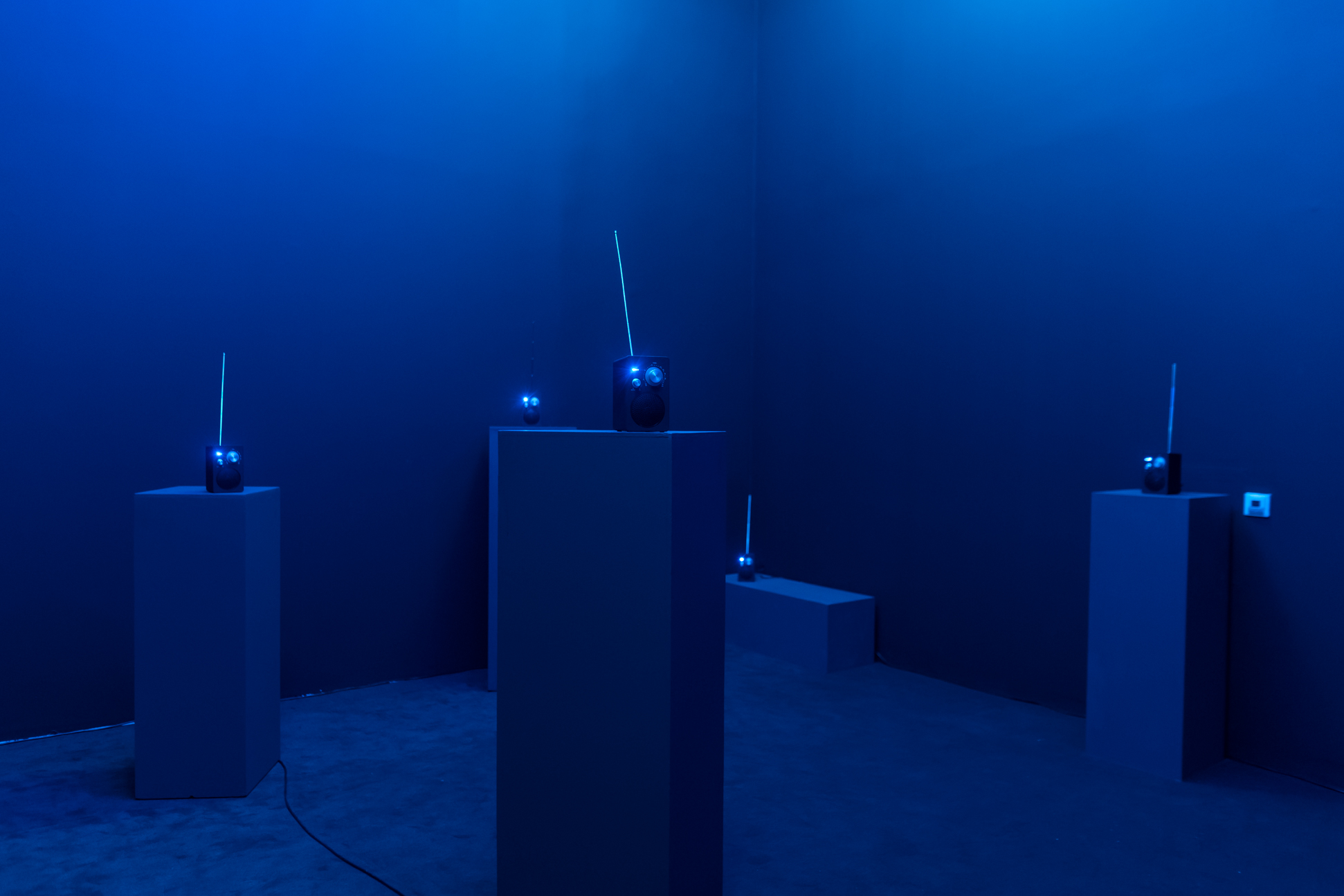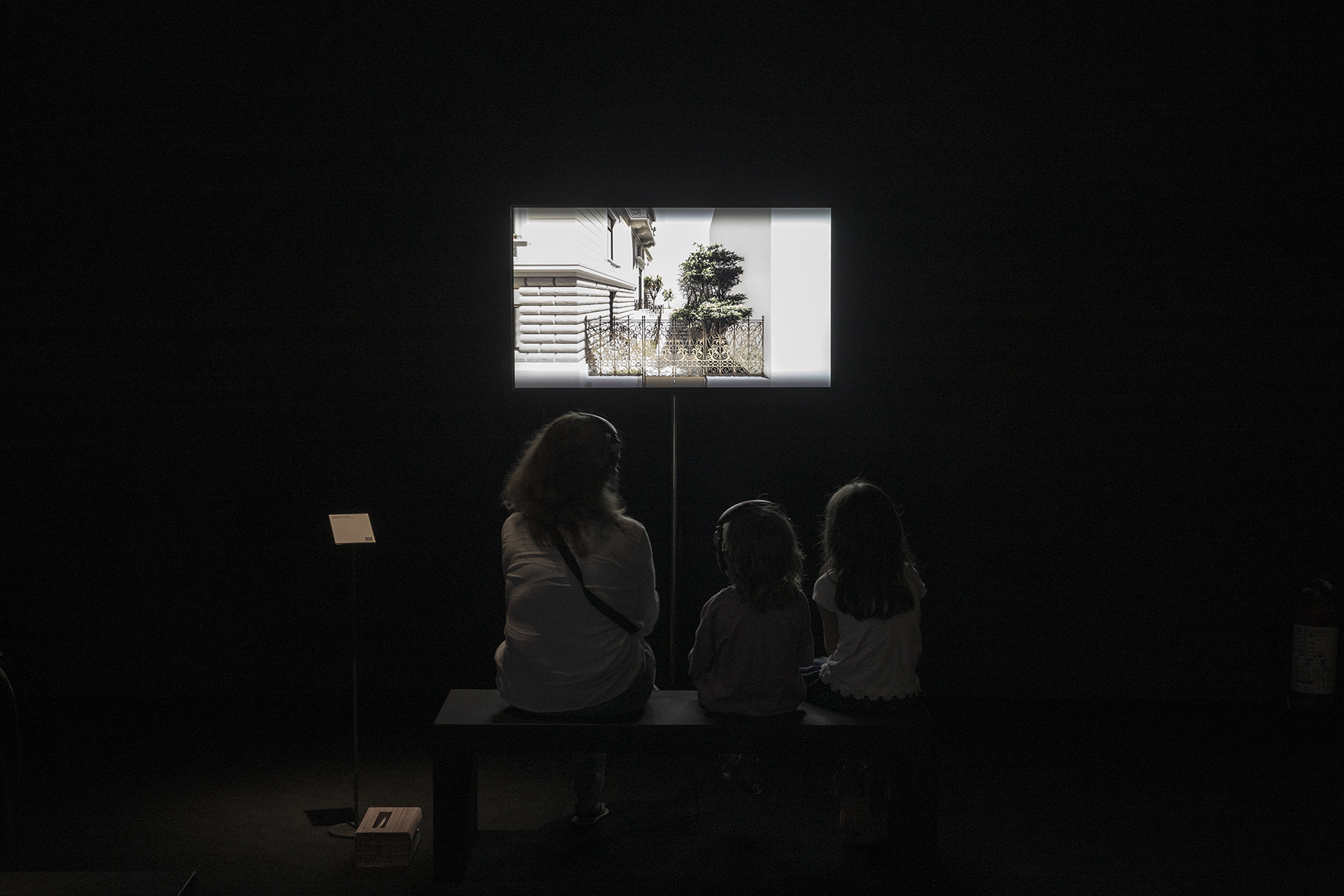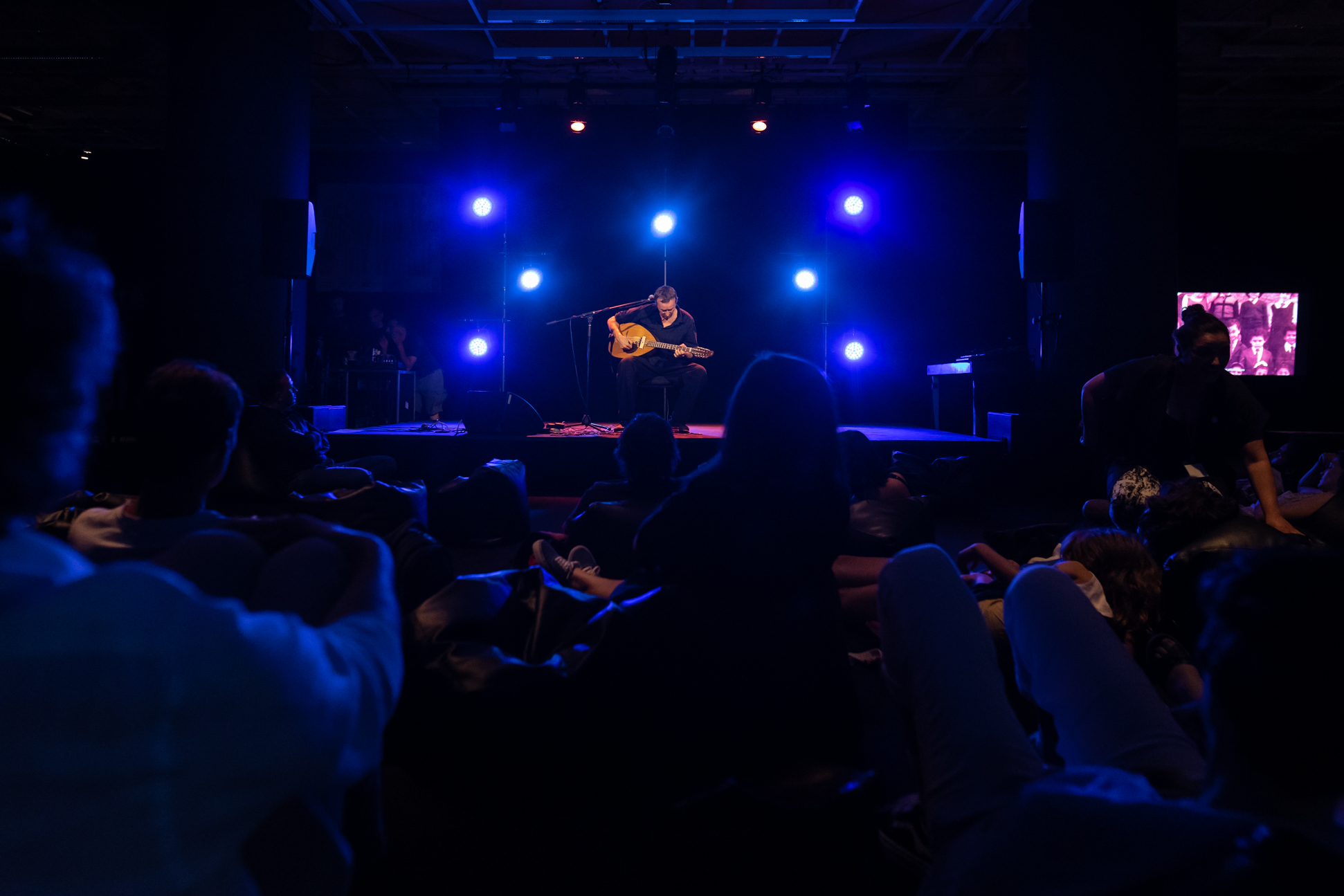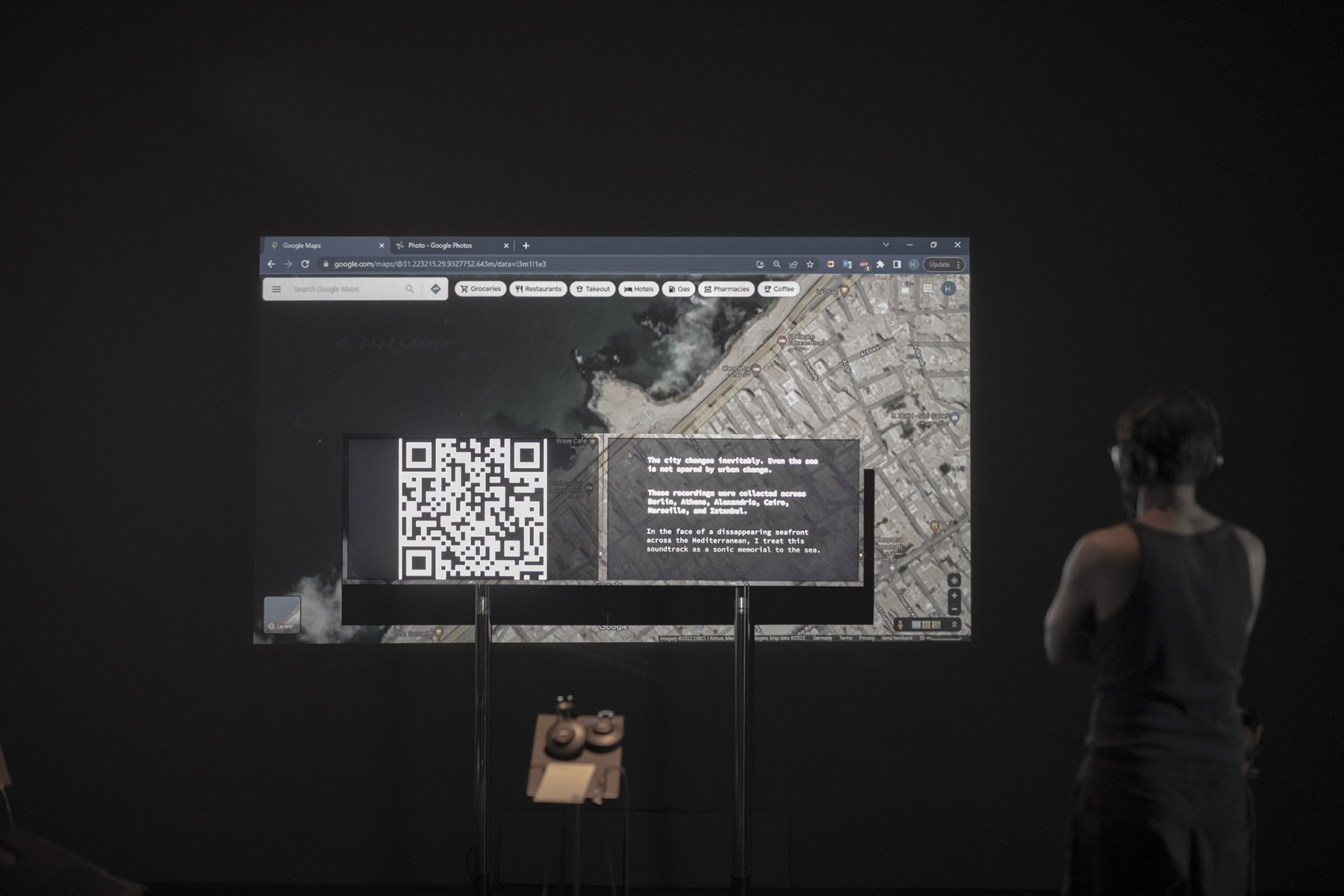School for Sonic Memory – Public Assembly
Public assembly – June 17-26, 2022
Onassis Stegi – Athens, Greece
Six nomadic and nine local residents explore the ways in which Marseille, Athens, and Alexandria resonate with one another. The circulation of knowledge, migration, water, heritage, mythology, memory, and the notion of citizenship examined through scores, images, texts, smells, choreography, music, and recorded sounds.
The School for Sonic Memory public assembly embodies the journey of fifteen international artists, urbanists, and practitioners to three Mediterranean cities: Athens, Alexandria, and Marseille. In collaboration with Onassis Stegi and Theatrum Mundi, six nomadic and nine local residents explore the ways in which these cities across the Mediterranean resonate with one another. In the context of this exhibition, ‘resonance’ is understood both literally and metaphorically, identifying trans-Mediterranean sonic practices that reveal the role each city’s sounds play in the dreams, nostalgias, and hopes of another. It also brings to the fore the elements of a connected and conflictual past audible within them.
Spanning across a variety of mediums and disciplines, the pieces are informed by the individual experiences and collective exchanges that took place during the week-long visits to Athens, Alexandria, and Marseille.
Through a multisensorial exploration comprising scores, images, texts, smells, choreography, music, and recorded sounds, the authors respond to some of the wider themes emerging from the residency: the circulation of knowledge, migration, water, heritage, mythology, memory, and the notion of citizenship.
An invitation to embark on a travel across the Mediterranean basin offering alternative narratives of what it means, or might mean, to belong to a sea rather than a country.
Public program:
Friday, June 17 2022
19:00 – 19:15 | Welcoming notes and Introduction to the School for Sonic Memory
19:30 – 19:45 | We will meet at the vanishing point, Youmna Saba
20:00 – 20:40 | The South inside, Sam Karpienia
21:00 – 22:00 | Akoo-o listening session
Saturday, June 18 2022
16:00 – 18:00 | Mapping Workshop, Cluster
19:30 – 19:45 | We will meet at the vanishing point, Youmna Saba
20:00 – 20:40 | A Ten years walk to shore, Ahmed Saleh
Works:
Asmaa Jama
Everything returns from the water, whole and silver
Asmaa is interested in working with oral histories and multiple voices and has created a piece of fiction that explores new possibilities for the future and alternative narratives rather than revisiting the past. This piece, “Everything returns from the water, whole and silver,” explores the waters around East and North Africa, and the different sounds, narratives, myths, histories that overlap within it through the creation of a fictional character based on the sea, inventing a mythology and folklore around this figure. Based on this mercreature/ gabarmanyo, Jama has created an audiovisual piece, collaborating with Sami El-Anany and digital artist Miriam Abraham.
Hatem Hegab
7adir-Ghā2ib // Present Absence
“7adir-Ghā2ib,” Arabic for ‘present absence’, explores memory through sound by examining what haunts the Mediterranean city. Departing from the sea, “7adir-Ghā2ib” moves inwards towards Alexandria to understand both the relationship of residents with the sea, and the impact of urban change on the city. The piece infuses sounds based on field recordings in Alexandria, Marseille, and Athens with personal histories in Alexandria to explore the ‘present absence’ of the Mediterranean. Using both sound and text, “7adir-Ghā2ib” weaves together space and time in Alexandria in an homage to the writer’s roots by the sea.
Maria Sideri & Monai de Paula Antunes
Incessant Basin
“Incessant Basin” is an expanding sonic diary practice and a performative archive connected with a sound installation and a transmission environment. In this first act, the sound installation compiles recordings and sounds from the cities of Athens, Alexandria, and Marseille and other places in Greece and Egypt visited in between. The material collected during the School of Sonic Memory nomadic residency gives the stage to the materiality and to the agency of sounds to narrate their own stories of the cities and their watery lives. A transmission environment connected with a sound installation offers a dynamic structure to host and display this collection, in which the experience in the space generates the output.
Onyeka Igwe
I whisper into your mouth
A sensorial evocation and gesture towards sonic monumentality that explores the blurry and contentious liminality of utopian dreaming in touching distance and the realities of political defeat.
Youmna Saba
سنلتقي عند لحظة الاختفاء | We will meet at the vanishing point, Youmna Saba
A composition for three voices presented as a sound installation and performance. It reflects on the outsider’s gaze as a shaping instrument, and the voice as an active player in intervening on how existing structures are experienced and perceived.
Akoo-o
Recits
Drawing upon the concept of sonic monumentality, Papachristou and Samantas compose a sound piece by compiling and bringing together fragments of public memory, sketching a minor historiography of the present. Sonic monumentality, proposed by Akoo-o (Nikos Bubaris, Dana Papachristou, Yorgos Samantas) as the group’s prior contribution to Theatrum Mundi and Onassis Stegi’s “The City Talks Back” (2020-21), is a speculative concept to contemplate on public memory, its relation to history and to national imagination, and public space politics in aural terms. Special thanks to our interlocutors, who shared with us their memories.
Marilia Kastrouni
Redeeming Gossip
Under the pretense of universality or neutrality, women and their contribution to the urban environments remain neglected from heritage understandings. Drawing on scholars like Federici (2019) and Spacks (1982), this work aims to challenge the sector’s structural bias by highlighting the female practices of gossip as trans-Mediterranean elements of (intangible) urban heritage. Contrary to the typically pejorative undertones of gossip as empty, malevolent talks, the project emphasizes the practice’s educational and political value.
Natassa Dourida
How far is tomorrow?
This video is a tribute to the plethora of neglected historical buildings of the Mediterranean cities. As ordinary as monuments may be, they offer cities with the aura of what they once represented, grounding neighborhoods to their past. They seem to stand still for decades, silently lamenting their neglect, while engaged in the slow, dynamic processes water erosion can cause. This is the story of one of the many unutilized neoclassical buildings of Athens: they are made to live forever, and they would, if they were kept in continuous use, so that someone could observe and protect them from these slow dynamic processes. As local stakeholders never feel able to resolve the matter, they hope to be able to treat them with some well-deserved care in the near future; but who can tell how much time they have left?
Ahmed Saleh
A ten years walk to shore
The piece is a journey through the sonic memory of a sea and a city, discovering the possibilities of merging both sonic memories and experimentations with the harmonies they might produce. What if they merge? Harmonize? Tussle? How would all the memories sound underwater? Getting deeper to discover more personal sonic memories, images, and accumulations of the sunken city.
Mohamed Adel Dessouki
S is for School
“I’ve always been interested in memories, emotions, and social meanings embedded in the built environment. My current project focuses on the architecture of schools. Using narrative and archival materials, my video represents an autobiographical account that retells a personal history of an uncelebrated school in the city of Alexandria, from its foundation as a mid-19th century Scottish missionary school to its late 20th century’s post-colonial fate.”
Yasmine Houssein
Layers
“Layers” is a work-in-progress project observing the layers of the city of Alexandria while collapsing under the effects of climate change. As is the case with many historical cities, Alexandria’s many layers tell the stories of several cultures and identities, i.e. the Ptolemaic city, the Roman city, the Arab city, the Turkish city, the cosmopolitan city, the Egyptian city, the revolutionary city, and the city exposed to the flood. All the layers’ observation led to the “will not happen” end, no more romanticization of the end, no more Hollywoodian disaster end to Alexandria. The flood will not be one big tsunami with blue water in the streets; the flood is an everyday invasion of the sea that destroys all the historical layers and erases the memories of the city. “Happening” is the description of past tsunamis versus the danger of climate change.
Sam Karpiernia
The south inside
Sam Karpienia was born in Normandy and grew up in Port-de-Bouc, an industrial town west of Marseille. As a self-taught guitarist Sam was playing in a rock band, when in 1996 he learned the regional language Provençal, which became his singing language. He then met Manu Théron in Marseille and in 1998 founded Gacha Empega, one of the first Occitan polyphonic groups. In 2000, he released the first album of Dupain, a creative music group inspired by traditional music from the Mediterranean basin with social texts from the 19th century. Several projects followed, notably Forabandit, a trio between Istanbul and Marseille, based on Alevi and troubadour repertoires. Today, after a two-year break in the merchant navy as a sailor, Sam Karpienia has resumed his musical exploration between Anglo-Saxon and Mediterranean music with the group De la Crau.
Elena Biserna
The Resounding Flâneuse
Scores entertain a paradoxical relationship with time. In music, they are compositional tools. In other disciplines such as dance, they have a primarily memorial function and can be imagined as traces of past actions to be re-enacted in the future. In the same way, “The Resounding Flâneuse” contains the memory of my past experiences in Marseille and Athens as well as an invitation to write together possible futures. Considering urban planning and the social organization of space and time as systems that co-produce hegemonic relationships, including the patriarchal ones, the scores question (auditory) experiences at night from a gender perspective. They play on the categories of visibility and invisibility, silencing and resonance, to invite us to listen to our spatial practices but also to invest and reclaim public space through the vibration of our bodies.
Zoé Le Voyer
Sonic traces across the Mediterranean(s): in conversation with Ayoub Ait Taadouit
For several years, and from different places throughout the Mediterranean(s), Ayoub Ait Taadouit has been experimenting with sound, working as both a sound engineer and designer. Through his practice, he records, restitutes, and composes sonic fragments from Casablanca, Tangiers, or Marseille. Looking back at Ayoub’s recent works and his approach to sound, this conversation weaves reflections about the relationship between sound, nostalgia, dreaming, and the imprints that cities leave on humans.
Credits:
Curated by: John Bingham-Hall & Andrea Cetrulo (Theatrum Mundi)
Co-curated by: Christos J. Carras
Design, Scenography: Mariza Soulioti
Nomadic Residents: Asmaa Jama, Onyeka Igwe, Hatem Hegab, Monai De Paula Antunes, Youmna Saba, Maria Sideri Local Residents in Athens: Dana Papachristou, Yorgos Samantas, Natassa Dourida, Marilia Kastrouni
Local Residents in Alexandria: Yasmine Hussein, Ahmed Saleh, Mohamed Adel Dessouki
Local Residents in Marseille: Zoé Le Voyer, Elena Biserna, Sam Karpienia
Associate Partners: French Institute of Alexandria, CLUSTER
Special Thanks to: Emiel Nguyen & Agathe Guillou, Mucem, Sarah Bahgat & B’Sarya









